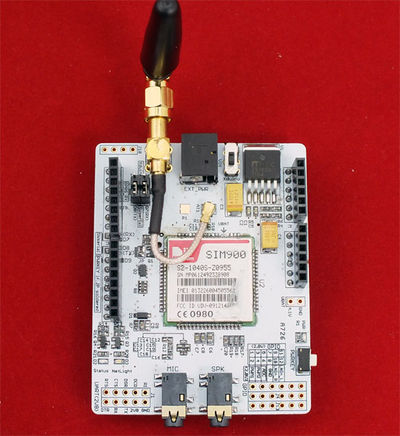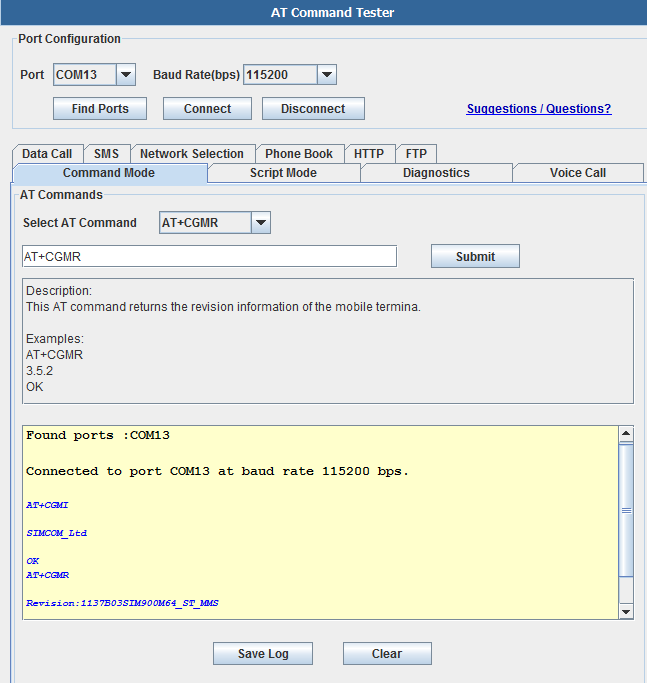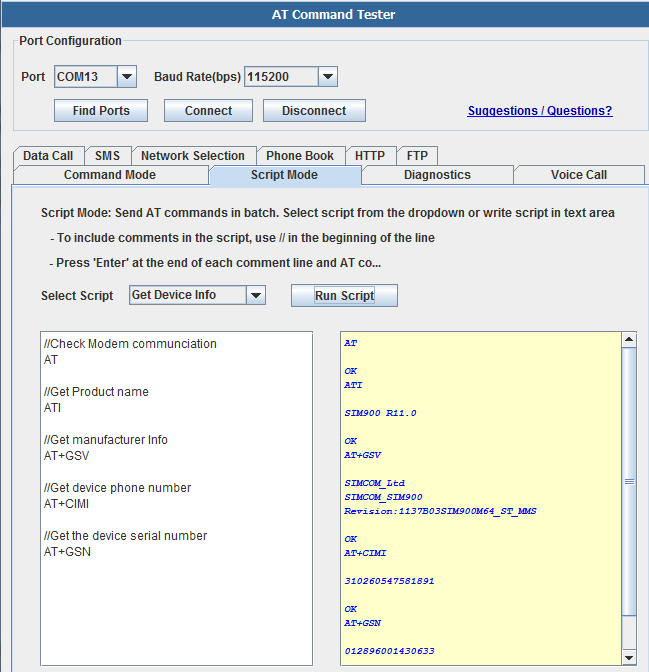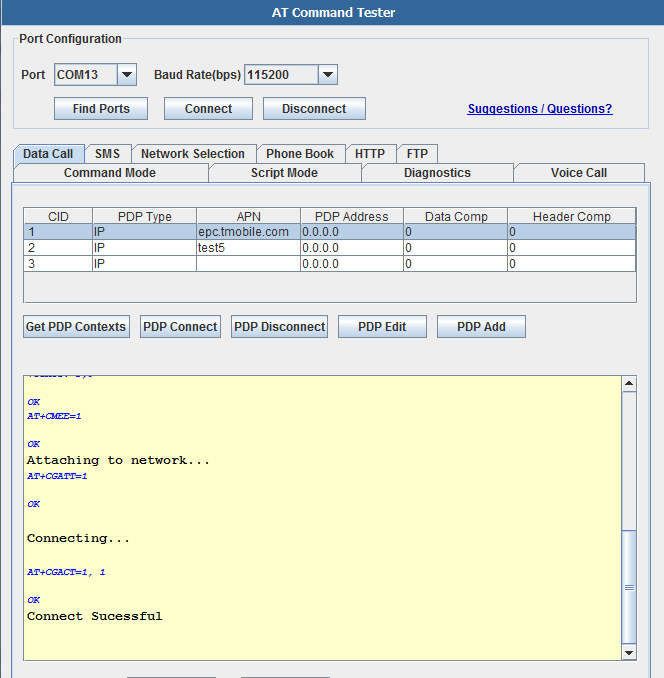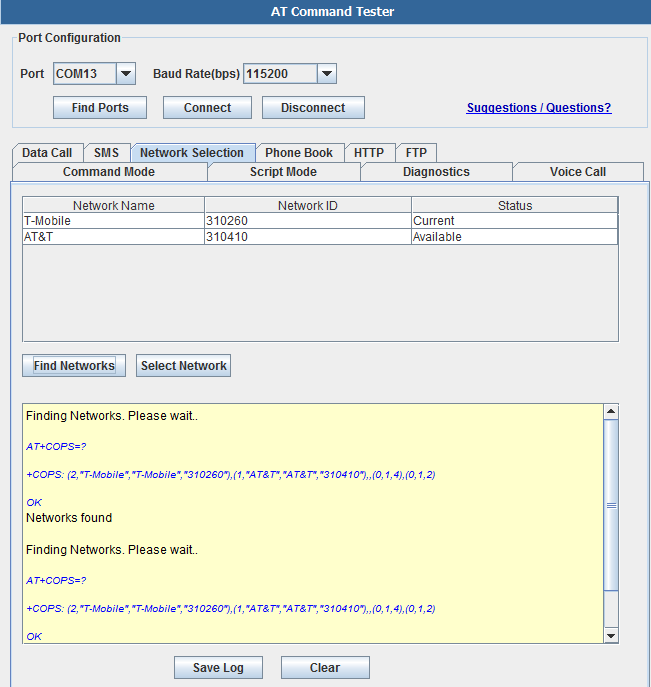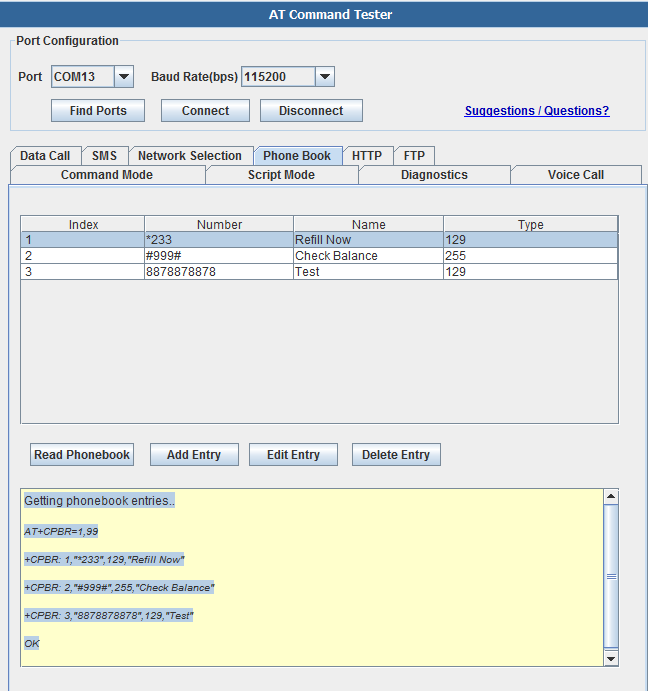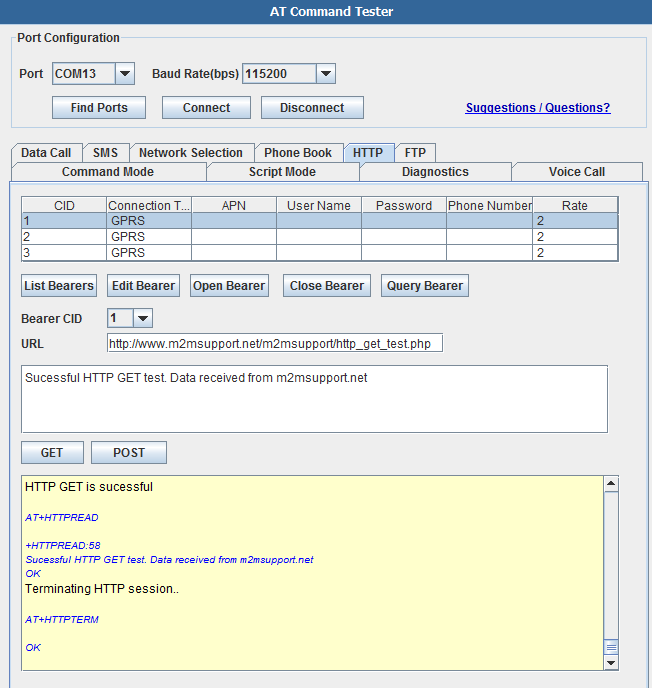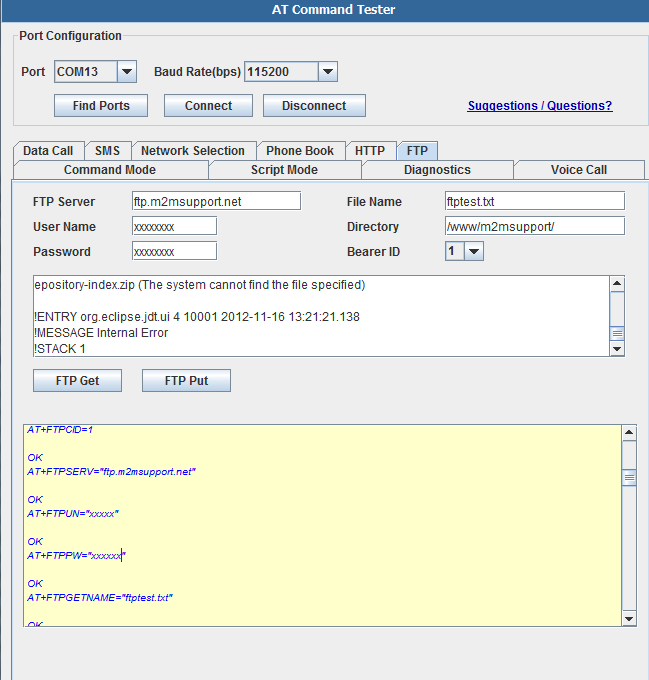SIM900 GPRS/GSM Shield
Contents
[hide]Introduction
The SIM900 GSM/GPRS Shield provides you a way to use the GSM cell phone network to receive data from a remote location. The shield allows you to achieve this via any of the three methods:
- Short Message Service
- Audio
- GPRS Service
The GPRS Shield is compatible with all boards which have the same form factor (and pinout) as a standard Arduino Board. The GPRS Shield is configured and controlled via its UART using simple AT commands. Based on the SIM900 module from SIMCOM, the GPRS Shield is like a cell phone. Besides the communications features, the GPRS Shield has 12 GPIOs, 2 PWMs and an ADC.
Features
- Based on SIMCom's SIM900 Module
- Quad-Band 850 / 900/ 1800 / 1900 MHz - would work on GSM networks in all countries across the world.
- Control via AT commands - Standard Commands: GSM 07.07 & 07.05 | Enhanced Commands: SIMCOM AT Commands.
- Short Message Service - so that you can send small amounts of data over the network (ASCII or raw hexadecimal).
- Embedded TCP/UDP stack - allows you to upload data to a web server.
- Speaker and Headphone jacks - so that you can send DTMF signals or play recording like an answering machine.
- SIM Card holder and GSM Antenna - present onboard.
- 12 GPIOs, 2 PWMs and an ADC (all 2.8 volt logic) - to augment your Arduino.
- Low power consumption - 1.5mA(sleep mode)
- Industrial Temperature Range - -40°C to +85 °C
Application Ideas
- M2M (Machine 2 Machine) Applicatoions - To transfer control data using SMS or GPRS between two machines located at two different factories.
- Remote control of appliances - Send SMS while you are at your office to turn on or off your washing machine at home.
- Remote Weather station or a Wireless Sensor Network : Create a sensor node capable of transferring sensor data (like from a weather station - temperature, humidity etc.) to a web server (like pachube.com).
- Interactive Voice Response System - Couple the GPRS Shield with an MP3 Decoder and DTMF Decoder (besides an Arduino) to create an Interactive Vocice Response System (IVRS).
- Vehicle Tracking System - Couple the GPRS Shield with an Arduino and GPS module and install it in your car and publish your location live on the internet. Can be used as a automotive burglar alarm.
Cautions
- Make sure your SIM card is unlocked.
- The product is provided as is without an insulating enclosure. Please observe ESD precautions specially in dry (low humidity) weather.
- The factory default setting for the GPRS Shield UART is 19200 bps 8-N-1. (Can be changed using AT commands).
Specifications
| Item | Min | Typical | Max | Unit |
|---|---|---|---|---|
| Voltage | 4.8 | 5.0 | 5.2 | VDC |
| Current | / | 50 | 450 | mA |
| Dimension(with antenna) | 110x58x19 | mm | ||
| Net Weight | 76±2 | g | ||
Interface Function
Power select - select the power supply for GPRS shield(external power or 5v of arduino)
Power jack - connected to external 4.8~5VDC power supply
Antenna interface - connected to external antenna
Serial port select - select either software serial port or hareware serial port to be connected to GPRS Shield
Hardware Serial - D0/D1 of Arduino/Seeeduino
Software serial - D7/D8 of Arduino/Seeeduino only
Status LED - tell whether the power of SIM900 is on
Net light - tell the status about SIM900 linking to the net
UART of SIM900 - UART pins breakout of SIM900
Microphone - to answer the phone call
Speaker - to answer the phone call
GPIO,PWM and ADC of SIM900 - GPIO,PWM and ADC pins breakout of SIM900
Power key - power up and down for SIM900
Pins usage on Arduino
D0 - Unused if you select software serial port to communicate with GPRS Shield
D1 - Unused if you select software serial port to communicate with GPRS Shield
D2 - Unused
D3 - Unused
D4 - Unused
D5 - Unused
D6 - Unused
D7 - Used if you select software serial port to communicate with GPRS Shield
D8 - Used if you select software serial port to communicate with GPRS Shield
D9 - Used for software control the power up or down of the SIM900
D10 - Unused
D11 - Unused
D12 - Unused
D13 - Unused
D14(A0) - Unused
D15(A1) - Unused
D16(A2) - Unused
D17(A3) - Unused
D18(A4) - Unused
D19(A5) - Unused
Note: A4 and A5 are connected to the I2C pins on the SIM900. The SIM900 however cannot be accessed via the I2C .
A Simple Source Code Example
The demo code below is for the Arduino to send SMS message/dial a voice call/submit a http request to a website and upload datas to the pachube. It has been tested on Arduino Duemilanove but will work on any compatible variant, plesse note that this sketch uses the sorfware UART of ATmega328P. please follow the following steps for running this sketch.
- With the GPRS Shield removed, download this sketch into your Arduino.
- Disconnect the Xduino from USB port to remove power source.
- Set the Serial Port jumpers on the GPRS Shield in SWserial position, to use the Soft Serial port of Arduino.
- Connect the antenna to the GPRS Shield and insert the SIM Card.
- Mount the GPRS Shield on Arduino.
- Connect the Arduino to the computer by USB, and fire up your favorite serial terminal software on computer, choose the COM port for Arduino, set it to operate at 19200 8-N-1.
- Type command in the terminal to execute different function, threr are 4 functions in the demo:
- If you input 't', the demo will send a SMS message to another cellphone which you set(you need set the number in the code);
- If you input 'd', the program will dial a call to the other cellphone that you set(it is also need you set in the code );
- If you input 'h', it will submit a http request to a web that you want to access(it need you set the web adress in the code), it will return a string from the website if it goes correctly;
- If you input 's', it will upload the datas to the pachube(for detail you can refer to the explanation in the code). I strongly recommend you input 'h' before input 's', because uploading data to the pachube need do some setting, after execute the function of submit a http request, the setting will be set.
- If the program returns error in the terminal after you typed the command, don't worry, just try input the command again.
<syntaxhighlight lang="c">
/*Note: this code is a demo for how to using gprs shield to send sms message, dial a voice call and
send a http request to the website, upload data to pachube.com by TCP connection, The microcontrollers Digital Pin 7 and hence allow unhindered communication with GPRS Shield using SoftSerial Library. IDE: Arduino 1.0 or later Replace the following items in the code: 1.Phone number, don't forget add the country code 2.Replace the Access Point Name 3. Replace the Pachube API Key with your personal ones assigned to your account at cosm.com */
- include <SoftwareSerial.h>
- include <String.h>
SoftwareSerial mySerial(7, 8);
void setup() {
mySerial.begin(19200); // the GPRS baud rate Serial.begin(19200); // the GPRS baud rate delay(500);
}
void loop() {
//after start up the program, you can using terminal to connect the serial of gprs shield,
//if you input 't' in the terminal, the program will execute SendTextMessage(), it will show how to send a sms message,
//if input 'd' in the terminal, it will execute DialVoiceCall(), etc.
if (Serial.available())
switch(Serial.read())
{
case 't':
SendTextMessage();
break;
case 'd':
DialVoiceCall();
break;
case 'h':
SubmitHttpRequest();
break;
case 's':
Send2Pachube();
break;
}
if (mySerial.available())
Serial.write(mySerial.read());
}
///SendTextMessage() ///this function is to send a sms message void SendTextMessage() {
mySerial.print("AT+CMGF=1\r"); //Because we want to send the SMS in text mode
delay(100);
mySerial.println("AT + CMGS = \"+86138xxxxx615\"");//send sms message, be careful need to add a country code before the cellphone number
delay(100);
mySerial.println("A test message!");//the content of the message
delay(100);
mySerial.println((char)26);//the ASCII code of the ctrl+z is 26
delay(100);
mySerial.println();
}
///DialVoiceCall ///this function is to dial a voice call void DialVoiceCall() {
mySerial.println("ATD + +86138xxxxx615;");//dial the number
delay(100);
mySerial.println();
}
///SubmitHttpRequest() ///this function is submit a http request ///attention:the time of delay is very important, it must be set enough void SubmitHttpRequest() {
mySerial.println("AT+CSQ");
delay(100);
ShowSerialData();// this code is to show the data from gprs shield, in order to easily see the process of how the gprs shield submit a http request, and the following is for this purpose too.
mySerial.println("AT+CGATT?");
delay(100);
ShowSerialData();
mySerial.println("AT+SAPBR=3,1,\"CONTYPE\",\"GPRS\"");//setting the SAPBR, the connection type is using gprs
delay(1000);
ShowSerialData();
mySerial.println("AT+SAPBR=3,1,\"APN\",\"CMNET\"");//setting the APN, the second need you fill in your local apn server
delay(4000);
ShowSerialData();
mySerial.println("AT+SAPBR=1,1");//setting the SAPBR, for detail you can refer to the AT command mamual
delay(2000);
ShowSerialData();
mySerial.println("AT+HTTPINIT"); //init the HTTP request
delay(2000);
ShowSerialData();
mySerial.println("AT+HTTPPARA=\"URL\",\"www.google.com.hk\"");// setting the httppara, the second parameter is the website you want to access
delay(1000);
ShowSerialData();
mySerial.println("AT+HTTPACTION=0");//submit the request
delay(10000);//the delay is very important, the delay time is base on the return from the website, if the return datas are very large, the time required longer.
//while(!mySerial.available());
ShowSerialData();
mySerial.println("AT+HTTPREAD");// read the data from the website you access
delay(300);
ShowSerialData();
mySerial.println("");
delay(100);
}
///send2Pachube()/// ///this function is to send the sensor data to the pachube, you can see the new value in the pachube after execute this function/// void Send2Pachube() {
mySerial.println("AT+CGATT?");
delay(1000);
ShowSerialData();
mySerial.println("AT+CSTT=\"CMNET\"");//start task and setting the APN,
delay(1000);
ShowSerialData();
mySerial.println("AT+CIICR");//bring up wireless connection
delay(3000);
ShowSerialData();
mySerial.println("AT+CIFSR");//get local IP adress
delay(2000);
ShowSerialData();
mySerial.println("AT+CIPSPRT=0");
delay(3000);
ShowSerialData();
mySerial.println("AT+CIPSTART=\"tcp\",\"api.cosm.com\",\"8081\"");//start up the connection
delay(2000);
ShowSerialData();
mySerial.println("AT+CIPSEND");//begin send data to remote server
delay(4000);
ShowSerialData();
String humidity = "1031";//these 4 line code are imitate the real sensor data, because the demo did't add other sensor, so using 4 string variable to replace.
String moisture = "1242";//you can replace these four variable to the real sensor data in your project
String temperature = "30";//
String barometer = "60.56";//
mySerial.print("{\"method\": \"put\",\"resource\": \"/feeds/42742/\",\"params\"");//here is the feed you apply from pachube
delay(500);
ShowSerialData();
mySerial.print(": {},\"headers\": {\"X-PachubeApiKey\":");//in here, you should replace your pachubeapikey
delay(500);
ShowSerialData();
mySerial.print(" \"_cXwr5LE8qW4a296O-cDwOUvfddFer5pGmaRigPsiO0");//pachubeapikey
delay(500);
ShowSerialData();
mySerial.print("jEB9OjK-W6vej56j9ItaSlIac-hgbQjxExuveD95yc8BttXc");//pachubeapikey
delay(500);
ShowSerialData();
mySerial.print("Z7_seZqLVjeCOmNbEXUva45t6FL8AxOcuNSsQS\"},\"body\":");
delay(500);
ShowSerialData();
mySerial.print(" {\"version\": \"1.0.0\",\"datastreams\": ");
delay(500);
ShowSerialData();
mySerial.println("[{\"id\": \"01\",\"current_value\": \"" + barometer + "\"},");
delay(500);
ShowSerialData();
mySerial.println("{\"id\": \"02\",\"current_value\": \"" + humidity + "\"},");
delay(500);
ShowSerialData();
mySerial.println("{\"id\": \"03\",\"current_value\": \"" + moisture + "\"},");
delay(500);
ShowSerialData();
mySerial.println("{\"id\": \"04\",\"current_value\": \"" + temperature + "\"}]},\"token\": \"lee\"}");
delay(500);
ShowSerialData();
mySerial.println((char)26);//sending
delay(5000);//waitting for reply, important! the time is base on the condition of internet
mySerial.println();
ShowSerialData();
mySerial.println("AT+CIPCLOSE");//close the connection
delay(100);
ShowSerialData();
}
void ShowSerialData() {
while(mySerial.available()!=0) Serial.write(mySerial.read());
} </syntaxhighlight>
AT Command Tester Application
AT Command Tester is a free online tool test AT Commands and other modem functionalities of 2G modules (GPRS/EDGE) , 3G Modules (HSDPA/EVDO) and 4G Modules (LTE).AT Command Tester tool connects to the modem port of the device and can test various modem functions such as getting device information, gprs data call, voice call,http access, checking signal condition, network registration, SMS functions, SIM access, phonebook functions etc.
In the 'Port Configuration' section of the tool, users can search for available ports using the 'Find Ports' button. Then using the 'Connect' button, users can connect to the modem port of the device.
In the 'Command Mode' tab of AT Command Tester, single AT commands can be sent. The drop down list provides AT command description and examples. Users can modify the default command settings.
Under the 'Script Mode' tab, multiple AT commands can be sent at a time. Users can add descriptive comments and save the script on their local machine.
Data Call
To make a data call with the modem, you need to connect to the APN of the carrier network. The carrier APN and other required information are stored in the SIM card and are referred as PDP contexts. Typically multiple PDP contexts are stored in the SIM for different call types. With the AT Command Tester you can edit/add/delete PDP contexts in a easy to use user interface.
Typical call setup sequence,
+CGDCONT: 1,"IP","epc.tmobile.com","0.0.0.0",0,0
+CGDCONT: 2,"IP","test5","0.0.0.0",0,0
+CGDCONT: 3,"IP","","0.0.0.0",0,0
OK
Checking registration status...
+CREG: 0,1
OK
The device is registered in home network.
Checking if device is already connected...
+CGACT: 1,0
+CGACT: 2,0
+CGACT: 3,0
OK
Attaching to network...
AT+CGATT=1
OK
Connecting...
OK
Connect Sucessful
SMS
The SMS tab of the 'AT Command Tester' tool provides the interfaces to send SMS messages. You can also list/view/delete SMS messages stored on the SIM.
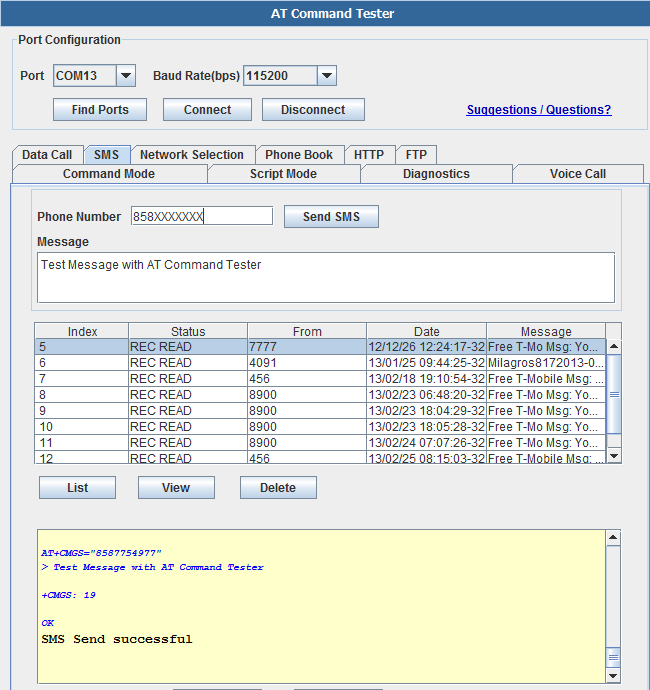
General sequence for sending SMS message,
Checking registration status...
+CREG: 0,1
OK
The device is registered in home network.
AT+CMGS="858XXXXXXX"
> Test Message with AT Command Tester�
+CMGS: 19
OK
SMS Send successful
Network Selection - This tab allows the user to manually select available networks. Modems are typically set for automatic network selection. 'Find Networks' button will command the modem to scan for available networks.
AT+COPS command will initiate network scan in the modem,
Finding Networks. Please wait..
+COPS: (2,"T-Mobile","T-Mobile","310260"),(1,"AT&T","AT&T","310410"),,(0,1,4),(0,1,2)
OK
Networks found
Phonebook
With the 'Phone Book' tab, you can add/delete/read phone book entries stored on the SIM,
Getting phonebook entries..
+CPBR: 1,"*233",129,"Refill Now"
+CPBR: 2,"#999#",255,"Check Balance"
+CPBR: 3,"8878878878",129,"Test"
OK
SIM900 HTTP
With the 'HTTP' tab, you can read the bearer profiles and test HTTP GET and HTTP POST,
Getting Bearer profiles..
AT+SAPBR=4,1
+SAPBR:
CONTYPE: GPRS
APN:
PHONENUM:
USER:
PWD:
RATE: 2
OK
AT+SAPBR=4,2
+SAPBR:
CONTYPE: GPRS
APN:
PHONENUM:
USER:
PWD:
RATE: 2
OK
AT+SAPBR=4,3
+SAPBR:
CONTYPE: GPRS
APN:
PHONENUM:
USER:
PWD:
RATE: 2
OK
Checking registration status...
+CREG: 0,1
OK
The device is registered in home network.
Querying bearer 1 .
AT+SAPBR=2,1
+SAPBR: 1,1,"162.184.222.162"
OK
Bearer 1 is Connected.IP address is "162.184.222.162"
Bearer 1 is Connected.
Initializing HTTP service...
OK
Error initializing HTTP service.
Setting up HTTP parameters..
AT+HTTPPARA="URL","http://www.m2msupport.net/m2msupport/http_get_test.php"
OK
AT+HTTPPARA="CID",1[[|]]
OK
AT+HTTPACTION=0
OK
HTTP GET is sucessful
+HTTPREAD:58
Sucessful HTTP GET test. Data received from m2msupport.net
OK
Terminating HTTP session..
OK
SIM900 FTP
FTP Get and Put with SIM900 module can be tested as shown below,
Checking registration status...
AT+CREG?
+CREG: 0,1
OK
The device is registered in home network.
Querying bearer 1 .
AT+SAPBR=2,1
+SAPBR: 1,1,"162.184.222.162"
OK
Bearer 1 is Connected.IP address is "162.184.222.162"
Bearer 1 is Connected.
Setting up FTP parameters..
OK
AT+FTPSERV="ftp.m2msupport.net"
OK
AT+FTPUN="xxxxxx"
OK
AT+FTPPW="xxxxxxx"
OK
AT+FTPGETNAME="ftptest.txt"
OK
AT+FTPGETPATH="/www/m2msupport/"
OK
AT+FTPGET=1
OK
+FTPGET:1,1
FTP session sucessfully started
AT+FTPGET=2,1024
+FTPGET:2,784
2-11-16 10:53:34.769 -----------------------------------------------
eclipse.buildId=M20120914-1800
java.version=1.6.0_16
java.vendor=Sun Microsystems Inc.
BootLoader constants: OS=win32, ARCH=x86, WS=win32, NL=en_US
Framework arguments: -product org.eclipse.epp.package.java.product
Command-line arguments: -os win32 -ws win32 -arch x86 -product org.eclipse.epp.package.java.product
!ENTRY org.eclipse.m2e.logback.appender 4 0 2012-11-16 12:11:54.493
!MESSAGE Unable to update index for central|http://repo.maven.apache.org/maven2: C:\Users\sgobi\.m2\repository\.cache\m2e\1.2.0\26522e0d83a422eed93329ece7565cfc\nexus-maven-repository-index.zip (The system cannot find the file specified)
!ENTRY org.eclipse.jdt.ui 4 10001 2012-11-16 13:21:21.138
!MESSAGE Internal Error
!STACK 1
OK
AT+FTPGET=2,1024
+FTPGET:2,0
OK
FTP data transfer is complete
+FTPGET:1,0
FTP session end
FAQ
Resources
- GPRS Shield v1.4 Schematic
- AT Commands v1.00 & AT Commands v1.03 & Hardware Design - SIM900 Documentation
- Si5902BDC - Dual N-Channel 30 V (D-S) MOSFETs (used for 2.8V <> 5.0V translation for Serial Interface)
- SIM900 firmware and tool(firmware:1137B08SIM900M64_ST) for firmware upgrade
- firmware:1137B09SIM900M64_ST
- SIM900datasheeet
